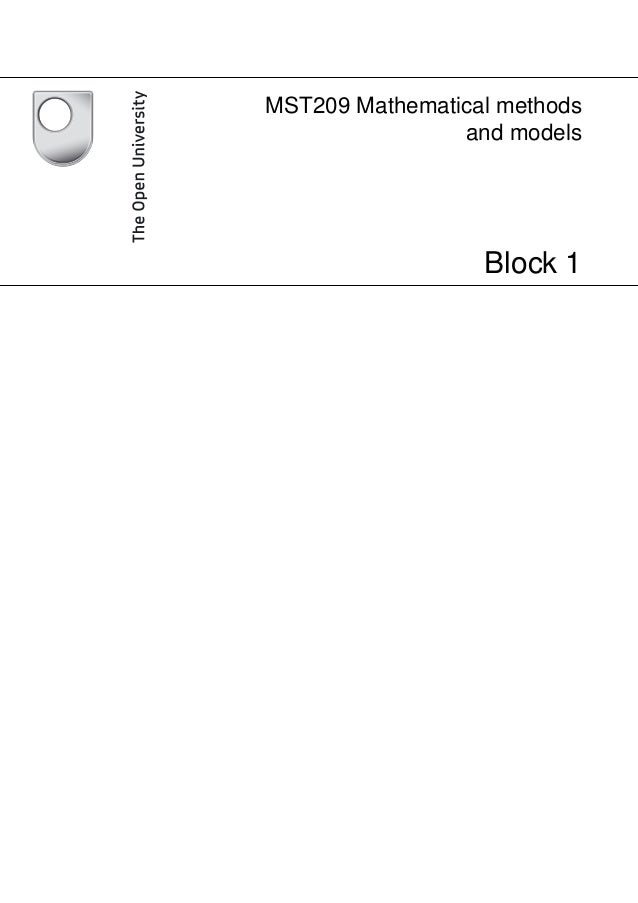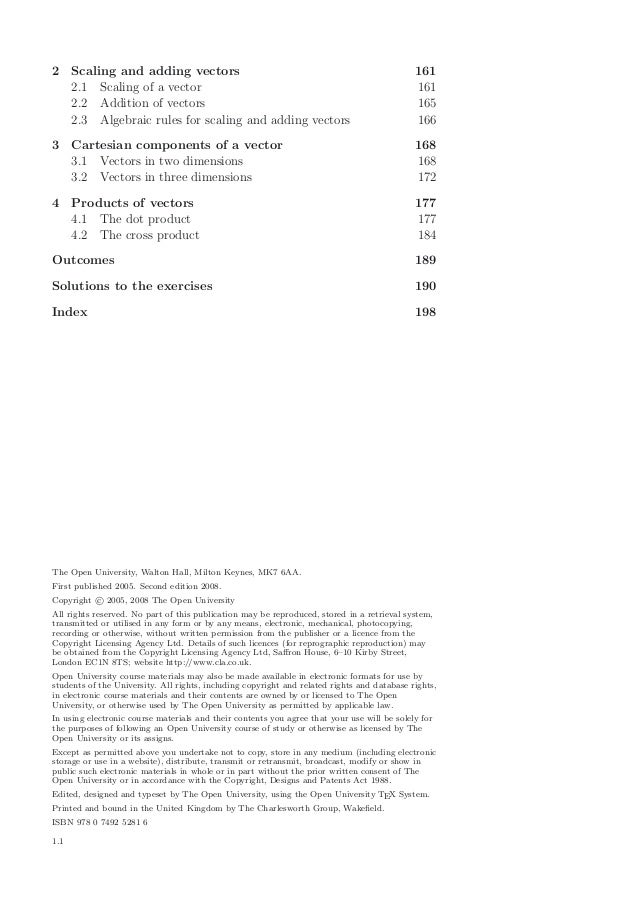Mst209 Mathematical Methods And Modeling Agencies London
Ebook mst209 block1e1i1n816l1 (2). 1.

Embed MST209 Mathematical Methods and Models. MST209 Mathematical methods and models First-order differential equations � � This unit introduces the topic of differential equations.
Onemodelplace Free
It is an important field of study, and several subsequent units are also devoted to it. There are many applications of differential equations throughout the course. The subject is developed without assuming that you have come across it before, but the unit assumes that you have previously had a basic grounding in calculus.
The goals of this course are: (1) to explain what it means to construct a mathematical model of some real-world phenomenon, (2) to introduce some of the mathematical ideas that are used in many such models, (3) to apply these methods to analyze one or more real problems, and (4) to understand how new mathematical ideas are motivated by such.
In particular, you will need to have a good grasp of the basic rules for differentiation and integration. (These were revised in Unit 1 of this course.) From the point of view of later studies, Sections 3 and 4 contain the most important material. The recommended study pattern is to study one section per study session, and to study the sections in the order in which they appear. You will need the computer algebra package for the course for Subsection 2.3 and for all of Section 5. The computer work for Subsection 2.3 may be postponed until later (for example until your study of Section 5) without affecting your ability to study the subsequent sections.
This publication forms part of an Open University course. Details of this and other Open Uni-versity courses can be obtained from the Course Information and Advice Centre, PO Box 724, The Open University, Milton Keynes, MK7 6ZS, United Kingdom: tel. +44 (0)1908 653231, e-mail general-enquiries@open.ac.uk Alternatively, you may visit the Open University website at where you can learn more about the wide range of courses and packs offered at all levels by The Open University.
To purchase a selection of Open University course materials, visit the webshop at www.ouw.co.uk, or contact Open University Worldwide, Michael Young Building, Walton Hall, Milton Keynes, MK7 6AA, United Kingdom, for a brochure: tel. +44 (0)1908 858785, fax +44 (0)1908 858787, e-mail ouwenq@open.ac.uk The Open University, Walton Hall, Milton Keynes, MK7 6AA. First published 2005. CCopyright 2005 The Open University All rights reserved; no part of this publication may be reproduced, stored in a retrieval system, transmitted or utilised in any form or by any means, electronic, mechanical, photocopying, record-ing or otherwise, without written permission from the publisher or a licence from the Copyright Licensing Agency Ltd. Details of such licences (for reprographic reproduction) may be obtained from the Copyright Licensing Agency Ltd, 90 Tottenham Court Road, London W1T 4LP. Open University course materials may also be made available in electronic formats for use by students of the University. All rights, including copyright and related rights and database rights, in electronic course materials and their contents are owned by or licensed to The Open University, or otherwise used by The Open University as permitted by applicable law.
In using electronic course materials and their contents you agree that your use will be solely for the purposes of following an Open University course of study or otherwise as licensed by The Open University or its assigns. What is hardware id. Except as permitted above you undertake not to copy, store in any medium (including electronic storage or use in a website), distribute, transmit or re-transmit, broadcast, modify or show in public such electronic materials in whole or in part without the prior written consent of The Open University or in accordance with the Copyright, Designs and Patents Act 1988. Edited, designed and typeset by The Open University, using the Open University TEX System.
Printed and bound in the United Kingdom by Martins the Printers Ltd, Berwick-upon-Tweed, TD15 1RS. ISBN 0 7492 6698 8 1.1 � � An important class of the equations that arise in mathematics consists of those that feature the rates of change of one or more variables with respect to one or more others.
These rates of change are expressed mathematically by derivatives, and the corresponding equations are called differential equations. Equations of this type crop up in a wide variety of situations. They are found, for example, in models of physical, electronic, economic, demographic and biological phenomena. First-order differential equations, which are the particular topic of this unit, feature derivatives of order one only; that is, if the rate of change of variable y with respect to variable x is involved, the equations feature dy/dx but not d 2 y/dx 2, d 3 y/dx 3, etc. When a differential equation arises, it is usually an important aim to solve the equation. For an equation that features the derivative dy/dx, this entails expressing the dependent variable y directly in terms of the independent variable x. The solution process requires the effect of the derivative to be ‘undone’.
The reversal of differentiation is achieved by integration, so it is to be expected that integration will feature significantly in the methods of solution for differential equations. Integration can be attempted either symbolically, to obtain an exact formula for the integral, or numerically, to give approximate numerical values from which the integral can be tabulated or graphed. The same two approaches can therefore be tried to obtain solutions of differential equations, and both are introduced in this unit. Section 1 considers in detail one example of how a differential equation arises in a mathematical model.


Model One
This is followed by some basic definitions and terminology associated with differential equations and their solutions. We also note how errors and accuracy are defined. Section 2 starts by looking at the direction field associated with a first-order differential equation. This is a device for visualizing the overall behaviour of the differential equation and of its solutions, and leads to a basic numerical method of solution known as Euler’s method. Both direction fields and Euler’s method are implemented in a computer subsection.
Section 3 turns to analytic (that is, symbolic) methods of solution, consid-ering first direct integration and then separation of variables. Section 4 describes a further analytic approach to solving differential equa-tions, called the integrating factor method. It applies only to equations that are linear.
Linear first-order differential equations are important in their own right, but also give valuable clues on how to solve linear second-order differential equations, which are the subject of Unit 3. In Section 5 you will see how each of the analytic methods from Sections 3 and 4 can be implemented on your computer. � � � � Subsection 1.1 develops a mathematical model for a specific situation which leads naturally to a first-order differential equation.
A key step in deriving this equation is to apply the input–output principle, which is a useful device for building relations between variables. Subsection 1.2 addresses what is meant by the term ‘solution’ in the context of first-order differential equations, and brings out the distinction between the general solution and the various possible particular solutions. The spec-ification of a constraint, or initial condition, usually permits us to find a unique function that is a particular solution of the differential equation and also satisfies the constraint. The short Subsection 1.3 provides the definition and description of numerical errors, in anticipation of Euler’s method in Section 2. � � In the course you will meet many examples of differential equations. Fre-quently these arise from studying the motion of physical objects, but we shall start with an example drawn from biology and show how this leads naturally to a particular differential equation. Suppose that we are interested in the size of a particular population, and in how it varies over time.
The first point to make is that any population size is measured in integers (whole numbers), so it is not clear how differentiation will be relevant. (Differentiable functions must be continuous, and therefore defined on an interval of real numbers in R.) Nevertheless, if the population is large, say in the hundreds of thousands, a change of one unit will be relatively very small, and in these circumstances we may choose to model the population size as a continuous function of time. We shall write this function as P ( t ), and our task is to show how P ( t ) may be described by a differential equation. Let us assume a fixed starting time (which we shall label t = 0). If the population is not constant, then there will be ‘leavers’ and ‘joiners’. For example, in a population of humans in a particular country, the former will be those who die or emigrate, whilst the latter represent births and immigrants.
It is usual to express birth rates as a proportion of the current population size. For example, the UK Office for National Statistics quotes birth rates in various age groups as a number per 1000 women. Death rates are specified in a similar way.
To emphasize that these rates are expressed as a proportion of the current population, we shall use the terms ‘proportionate birth rate’ and ‘proportionate death rate’. For our simple model we shall ignore immigration and emigration, and con-centrate solely on births and deaths. Denote the proportionate birth rate by b and the proportionate death rate by c. Then, in a short interval of time δt, we would expect number of births bP ( t ) δt, (1.1) number of deaths cP ( t ) δt, (1.2) where P ( t ) is the population size at time t.
Note that in our model the proportionate birth rate is expressed as a proportion of the whole population, not just the number of women.